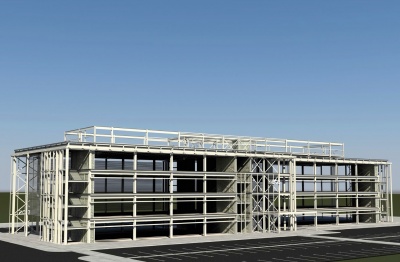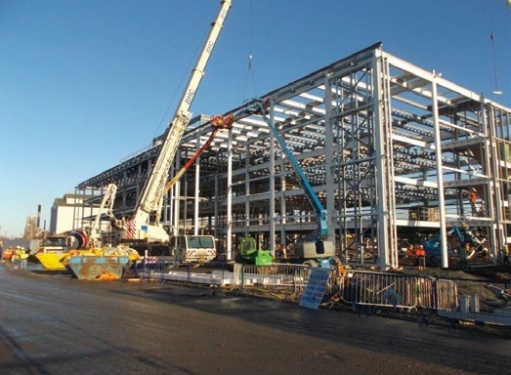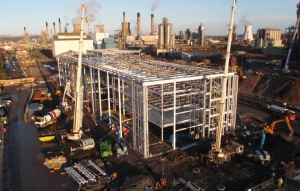Difference between revisions of "INEOS Headquarters, Grangemouth, Stirlingshire"
| (2 intermediate revisions by the same user not shown) | |||
| Line 1: | Line 1: | ||
| − | ==Article in [ | + | ==Article in [https://www.newsteelconstruction.com/wp/wp-content/uploads/digi/2016pdf/NSCmarch16digi.pdf#page=16 NSC March 2016]== |
{{#image_template:image=File:INEOS_HQ-1.jpg|align=right|wrap=true|width=400}} | {{#image_template:image=File:INEOS_HQ-1.jpg|align=right|wrap=true|width=400}} | ||
'''Ensuring a safe design'''<br> | '''Ensuring a safe design'''<br> | ||
| Line 55: | Line 55: | ||
|} | |} | ||
| − | [[Category:Case studies | + | [[Category:Case studies - Multi-storey office buildings]] |
Latest revision as of 16:22, 10 February 2021
Article in NSC March 2016
Ensuring a safe design
INEOS Olefins & Polymers UK, the country’s largest privately-owned company and one of the world’s largest chemical businesses, is building a new, state-of-the-art and blast resistant steel-framed headquarters.
Constructing a new office block within a large petrochemical works brings with it a host of unique challenges, the most important of which is to be blast resistant. In the event of an accident involving combustive materials, the new building must be able to withstand any possible resultant blast, all of which requires a number of considerations to be implemented during the design stage.
This is precisely the challenge set for the team currently constructing the £20M steel-framed headquarters building for INEOS at its Grangemouth facility in Stirlingshire. “Because of the location, the design stage for this project was more onerous than would be expected for a job of this size,” explains BAM Construction Project Manager Gary Brown. “Because the building is located within a major petrochemical complex the office HQ had to be designed to take this into account and so we employed a specialist blast engineer who had to review all of the initial designs, including the steel frame, secondary steel and cladding, to ensure everything was blast resistant.”
Woolgar Hunter Senior Engineer Kenneth Irvine says: “We worked closely with Michael Laird Architects to develop a solution for the steel frame and cladding, which addresses the loading issue but still provides an elegant and economic building. “The structural design had to take into account potential blast loadings and so the steel frame has to be flexible,” explains Mr Irvine.
The requirement for the steel frame to be ductile in the event of a blast led the design team to choose steel-framed cores for the building, instead of the more rigid concrete versions. All of the cross bracing comprises 250mm × 12mm flat sections which were chosen as this steelwork offers more flexibility.
The only areas where flexibility is not required are the connections between the cross bracing and the main frame’s columns. Here large stiffened connections have been designed to hold firm against blast loads.
The 6,500m2 steel-framed building will provide high-quality open-plan office space over four floors and will include meeting rooms, conference facilities and kitchens located on the ground floor.
Main contractor BAM Construction started work on the site in August 2015. The plot had already been cleared of its previous buildings, and so one of the initial tasks was to install a series of precast piles to a depth of between 35 and 40m. The completion of the piling works then allowed steelwork contractor BHC to begin its steel erection programme.
The steelwork forms a braced frame that is based around a regular grid pattern of 7.5m × 18m. A series of 18m-long × 750mm-deep Westok cellular beams has been used throughout the structure, not only to create the desired open plan space but also to efficiently accommodate all of the services within the structural void.
“We’ve erected the entire steel frame using two 80t-capacity mobile cranes,” says BHC Project Manager Bobby McCormick. “The 18m-long cellular beams, which each weigh 5.5t, were the heaviest and longest steel sections on the job.” BHC began by erecting the central area of the building, which contains the main core. Once this area was up and stable, the erection team was divided in two to work outwards in both directions simultaneously.
Although the structure is based around a large column-free design, there are a few internal columns and these are located around the centrally-positioned atrium and its adjacent core.
As well as the steelwork fabrication, supply and erection, BHC has also been responsible for the installation of metal decking and precast stairs. As well in the central core, precast staircases are also positioned at either end of the building in secondary steel-framed cores.
- The choice of steelwork has helped with a quick and cost effective construction programme
All intumescent painting has been carried out by BHC offsite at its fabrication yard. Again for blast resistance, the paint specified for this building is of a higher specification than usually applied to commercial structures.
A steel frame was chosen as the best framing solution for this scheme as it helps achieve a faster construction programme. The scheme is currently on schedule to meet its August completion date.
Creating a manufacturing hub
INEOS operates 65 petrochemical plants worldwide and this is its largest facility. The new building forms part of INEOS’ grand vision for the site as it plans to turn it into a manufacturing hub for the whole of the Central Belt of Scotland.
The company says the new building is just one part of the innovative redevelopment plans for Grangemouth. Old manufacturing plants and vacant buildings will make way for brownfield plots that will be made available to new businesses attracting investment into the area. These businesses will be able to benefit from the raw materials, existing power stream, logistics and other services provided by INEOS.
INEOS Olefins & Polymers CEO at Grangemouth John McNally says: “The site is undergoing a radical transformation with significant investment that will herald a new era in petrochemical manufacturing at Grangemouth. For the first time in many years, the business at Grangemouth will be able to bring its employees together in a way that suits the new business operation. It will improve productivity and collaboration with a single office building.”
| Architect | Michael Laird Architects |
| Structural Engineer | Woolgar Hunter |
| Steelwork Contractor | BHC |
| Main Contractor | BAM Construction |
| Main Client | INEOS UK |








